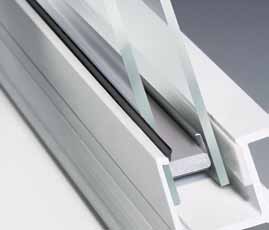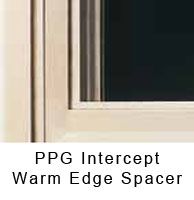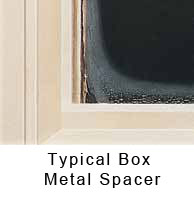HIGH-PERFORMANCE GLASS
Glass Essentials
What makes one glass system better than another?
What you need to know about high – performance glass
Insulated Glass – a combination of two or more panes of glass with hermetically sealed air space between.
Argon Gas – a safe, colorless, odorless, nonflammable, nontoxic inert gas that is heavier than air. This insulating gas between the panes of glass counteracts heat/cold conduction. It also helps reduce noise infiltration – so your home will be more energy efficient and quieter.
Krypton Gas – this super-insulating gas is denser than argon and therefore, provides better performance properties.
Low-E Glass – a special type of glass with microscopically thin, undetectable metallic coatings applied to its surface that act as a thermal barrier. In winter months, Low-E helps reduce heating costs by reflecting indoor heat back into the room. During the
summer, Low-E lets in visible sunlight while minimizing infrared and ultraviolet solar energy that can increase cooling costs and cause curtains, carpets and furniture to fade.
PPG Intercept Warm-Edge Spacer System – a sealed, one-piece alloy in a U-channel design that creates an effective thermal barrier to reduce conducted heat loss through the window.

The one-piece, U-shaped Intercept Warm-Edge Spacer is stronger and better at retaining insulating gas than many conventional designs.


The Intercept Warm-Edge Spacer keeps the edges of the window glass warmer and reduces condensation problems around the window perimeter. Although both windows pictured above are built with Low-E glass and filled with argon gas, the window with the Intercept Warm-Edge Spacer maintains superior thermal performance despite fluctuations in temperature.
High R-Value – R-value is the resistance to heat flow, so the higher the R-value the better the insulating performance.
Low U-Factor – U-factor (also referred to as U-value) represents the rate of heat flow through a glazing system. The lower the U-factor, the greater the resistance to heat flow and the better the insulating power.
SHGC – Solar Heat Gain Coefficient represents the fraction of solar radiation admitted through a window. The lower the SHGC, the less solar heat the window transmits into the home, which can help reduce air-conditioning costs during summer months.
Energy Glass Upgrades – for even greater energy savings, ask about Alside’s ClimaTech high-performance glass packages with additional energy-efficient features.

